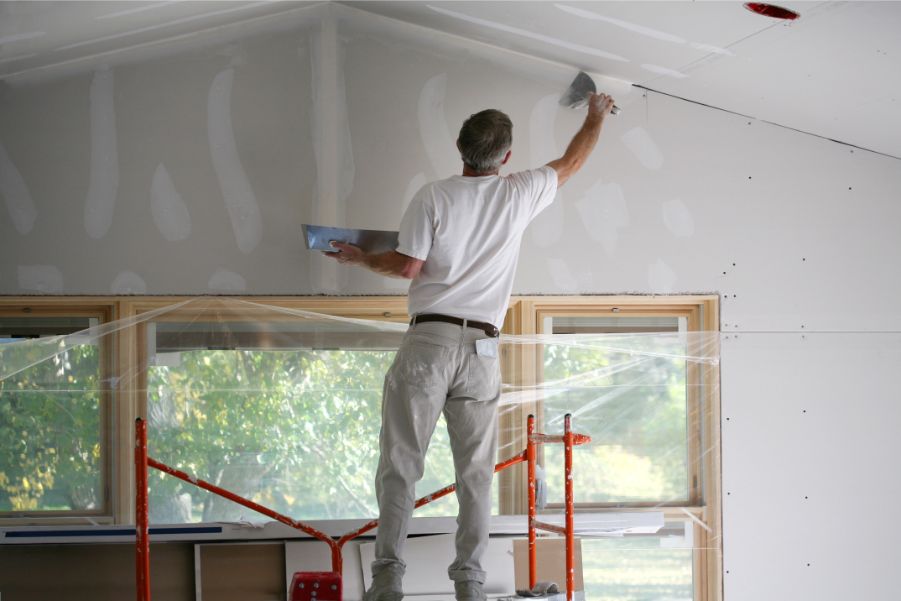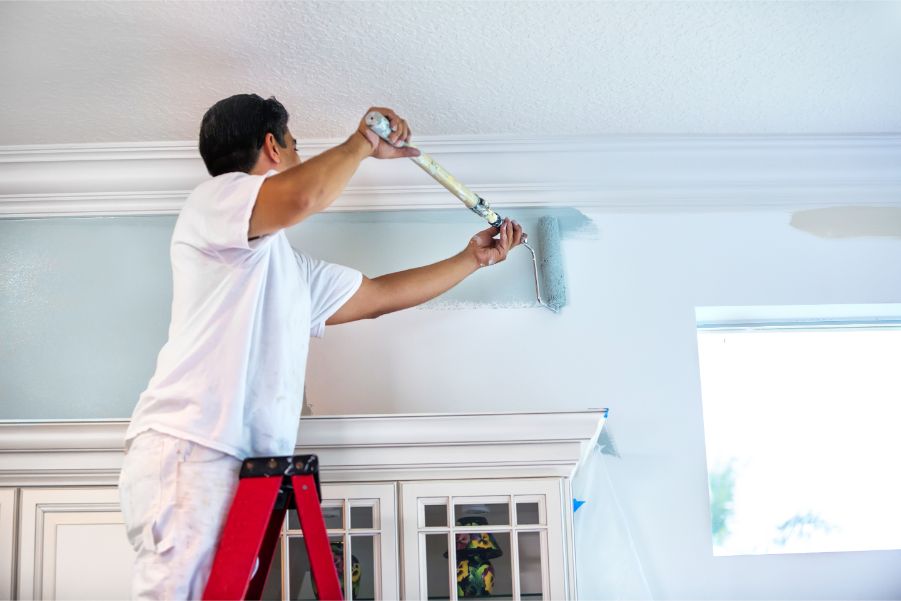Your home’s walls are built to be sturdy, durable and last for a very long time. But, that doesn’t mean they’re invincible — holes, scratches and other types of wall damage are all part of everyday wear and tear. However, drywall repairs can be an intimidating project to take on. Fortunately, there are economical ways to do wall repairs and creative painting tactics to make you forget the damage ever happened. And, Paintzen can walk you through the step-by-step process. So, read on for the basics of wall repair, including the best methods on how to fix a wall, how to patch a drywall hole and how paint can beautifully cover a newly repaired area.
Tools Required
The basic materials you will need to repair a hole in the wall are sandpaper*, a putty knife, spackle or plaster, a wall hole patch, a dust mask, a utility knife and a wet sponge.

Fixing a Small Hole in Drywall
Fixing a small hole in drywall is simple with the right tools and can be done quickly. First, remove loose debris from the damaged area before starting your drywall repair. Most of these jobs can be done with a wall hole patch kit. Read on for step-by-step instructions when repairing drywall.
Step One: Removing Debris and Sanding
After removing debris and sanding* the hole’s edges, place a wall hole patch over the area. You can get a wall hole patch kit at any hardware store or online.
Step Two: Smooth Edges
Then place a wall hole patch on the wall using a wet sponge. Next, use a putty knife to apply spackle or plaster around the hole and to smooth the edges of the patch with spackling.
Step Three: Sand Down and Make Flush
Next, it’s essential to do sanding* after spackling. Use sandpaper* to sand* down the dried spackle to make it flush with the wall. After doing this type of drywall repair, you may want to spot prime the area before moving on to the painting portion of the project.
Fixing a Large Hole in Drywall
There are different approaches to fix a hole in the wall, depending on the size of the hole. A hole is considered large if it is bigger than six inches in diameter. This larger hole requires more support and creativity to repair. Below are the most commonly used strategies for how to patch a hole in drywall when you need to fix holes larger than six inches.
Step One: Even out the hold
When you’re fixing a large hole in drywall, cut the hole into a clean square.
Step Two: Insert lumbar
Then, put a 1×3 piece of lumbar into each side of the hole and screw the lumbar into the wall.
Step Three: Secure the drywall
Next, cut a piece of drywall to fit into the hole and secure the drywall with drywall screws.
Step Four: Spread the compound
Last, spread compound around the edges of the drywall. After the compound has dried, sand the surface and apply at least two more coats. Sand one final time before priming and painting.

How to paint over spackle repairs
It’s important to properly repair a wall before painting it, but once the area is dry and smooth, you are ready to prime the surface. Primer is essential because it helps fill imperfections and allows the top coat of paint to adhere to the surface better. Paint the wall in all directions with the primer for the best coverage, and then move on to your desired paint color.
Small wall holes can often be easily painted over and never noticed again. However, large holes may require a bit more creativity. To draw attention away from textural differences due to a wall repair, consider painting over the entire area with a drastically dark color to serve as an accent wall.
You can also incorporate a custom mural onto the affected wall to distract your eyes from the damage and liven up the space. Perhaps your wall damage was a benefit in disguise to help you take a fun new direction with your interior design!
How Paintzen Can Help Make Your Wall Beautiful Again
Paintzen specializes in painting projects, and our skilled contracting crews can also repair and install drywall, and add skim coating to create a smooth finish before starting to paint. Additionally, Paintzen project managers can help inspire you with a wide variety of custom painting services, such as hand-painted murals, logo painting Venetian plaster and specialty faux finishes. Visit our color gallery and order our paint swatches to see how the colors look on your wall.
Whether your wall damage is minor or major, we are your reliable local source for all things painting and wall coverings. In addition, our revolutionary quoting technology can give you an up-front estimate of what your project will cost. So, request a fast and free quote online now or give us a call at 866-343-9981 to stop stressing over your drywall repair woes and enjoy every square inch of your beautiful home.
*WARNING! If you scrape, sand, or remove old paint, you may release lead dust. LEAD IS TOXIC. EXPOSURE TO LEAD DUST CAN CAUSE SERIOUS ILLNESS, SUCH AS BRAIN DAMAGE, ESPECIALLY IN CHILDREN. PREGNANT WOMEN SHOULD ALSO AVOID EXPOSURE. Wear a NIOSH-approved respirator to control lead exposure. Clean up carefully with a HEPA vacuum and a wet mop. Before you start, find out how to protect yourself and your family by contacting the National Lead Information Hotline at 1-800-424-LEAD or log on to www.epa.gov/lead.